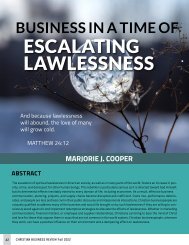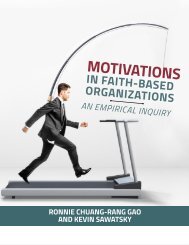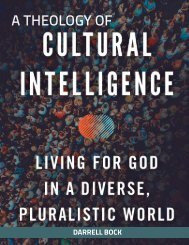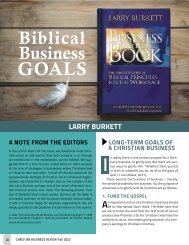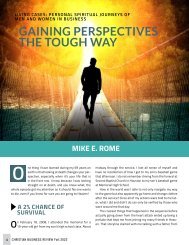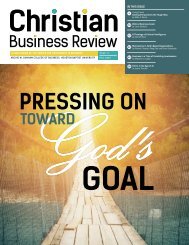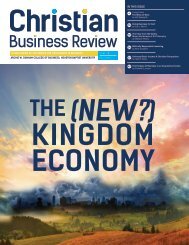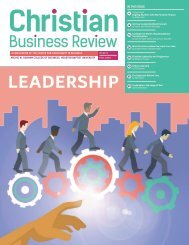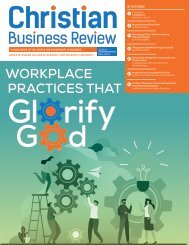Christian Business Review 2018: Kingdom Business in the Brave New World (Issue 7)
You also want an ePaper? Increase the reach of your titles
YUMPU automatically turns print PDFs into web optimized ePapers that Google loves.
communication technologies<br />
me and God,” but ra<strong>the</strong>r <strong>in</strong> community. This helps us get<br />
beyond our own self-justification and lack of self-awareness.<br />
In an earlier era, Forrester and Drexler 32 <strong>in</strong>troduced a<br />
way of us<strong>in</strong>g <strong>the</strong> various modes of communication for <strong>the</strong><br />
effective performance of a team, focus<strong>in</strong>g on face-to-face<br />
communication for trust build<strong>in</strong>g, us<strong>in</strong>g same time/different<br />
place tools for clarification of goals and objectives, and<br />
f<strong>in</strong>ally do<strong>in</strong>g <strong>in</strong>dividual work with updates communicated<br />
through asynchronous communication. As technologies<br />
become more capable, each needs to be exam<strong>in</strong>ed for its<br />
ability to support <strong>the</strong> different motivations for communication,<br />
and used appropriately. For example, could we<br />
effectively build trust through a holographic discussion<br />
or a video chat session, or does trust require physical<br />
presence with someone? In addition, <strong>the</strong> cost of <strong>in</strong>teraction<br />
<strong>in</strong> a relationship must be considered. Work<strong>in</strong>g with a<br />
colleague on <strong>the</strong> o<strong>the</strong>r side of <strong>the</strong> world, we might know<br />
that face-to-face would be desirable but travel costs may<br />
make it prohibitive.<br />
Future Directions<br />
There are many considerations we have not covered or<br />
only h<strong>in</strong>ted at <strong>in</strong> this paper. Throughout <strong>the</strong> preced<strong>in</strong>g<br />
sections we have referenced relationships primarily<br />
between two <strong>in</strong>dividuals. But we also have relationships<br />
with non-human entities, <strong>in</strong>clud<strong>in</strong>g with our pets, with <strong>in</strong>animate<br />
objects (e.g., cell phones, Roomba vacuums), with<br />
companies, and with artificial <strong>in</strong>telligence (e.g., Siri or<br />
Alexa). What pr<strong>in</strong>ciples should guide our <strong>in</strong>teractions <strong>in</strong><br />
such non-<strong>in</strong>terpersonal relationships? This may become<br />
<strong>in</strong>creas<strong>in</strong>gly important as technology <strong>in</strong>creas<strong>in</strong>gly blurs<br />
<strong>the</strong> l<strong>in</strong>e between objects and people.<br />
We have not discussed <strong>the</strong> ways <strong>in</strong> which organizational<br />
contexts might shape <strong>the</strong> impact of technology on<br />
relationships. For example, <strong>the</strong> position someone has <strong>in</strong><br />
an organizational hierarchy might make <strong>the</strong> use of technology<br />
more or less appropriate <strong>in</strong> <strong>the</strong>ir <strong>in</strong>teractions with<br />
o<strong>the</strong>rs. Similarly, <strong>the</strong> role of <strong>the</strong> <strong>in</strong>dividual with whom you<br />
CBR PEER REVIEWED ARTICLES<br />
are <strong>in</strong>teract<strong>in</strong>g (e.g., customer, supplier, or community<br />
member) may also <strong>in</strong>fluence <strong>the</strong> type of technology that<br />
is appropriate, or <strong>the</strong> extent to which it ought to be used.<br />
We are not aware of research that has exam<strong>in</strong>ed <strong>the</strong> faith<br />
commitments of those <strong>in</strong> organizational leadership and<br />
<strong>the</strong> extent to which such values <strong>in</strong>fluence <strong>the</strong> decisions<br />
that are made about us<strong>in</strong>g technology. For example, are<br />
<strong>Christian</strong>s any more likely than o<strong>the</strong>rs to draw on <strong>the</strong>ological<br />
pr<strong>in</strong>ciples <strong>in</strong> consider<strong>in</strong>g how to use technology?<br />
Future studies may well add value to <strong>the</strong> discussion of <strong>the</strong><br />
impact of technology on relationships by consider<strong>in</strong>g various<br />
and nuanced organizational contexts.<br />
F<strong>in</strong>ally, <strong>the</strong>re are a number of ways <strong>in</strong> which technology<br />
may <strong>in</strong>fluence <strong>in</strong>dividuals, which we have not discussed.<br />
For example, <strong>the</strong>re is empirical research demonstrat<strong>in</strong>g<br />
<strong>the</strong> impact of “screens” on children’s bra<strong>in</strong> development,<br />
and a number of questions raised about <strong>the</strong> potentially<br />
addictive nature of some technologies. Should <strong>the</strong>re<br />
be limits associated with our use of some technology?<br />
Does this depend on age, gender, personality, etc.? Does<br />
<strong>the</strong> Scriptural mandate for Sabbath apply to our use of<br />
technology? That is, if technology is a tool that helps us<br />
to work, <strong>the</strong>n limit<strong>in</strong>g its use one day per week would be<br />
consistent with <strong>the</strong> concept of Sabbath keep<strong>in</strong>g. 33 Is <strong>the</strong>re<br />
a difference between productive and consumptive use of<br />
technology <strong>in</strong> terms of its impact on <strong>the</strong> <strong>in</strong>dividual? Does<br />
<strong>the</strong> way <strong>in</strong> which a technology is be<strong>in</strong>g used have a bear<strong>in</strong>g<br />
on its value? If so, are <strong>the</strong>re criteria that can guide our<br />
assessment of it and decision mak<strong>in</strong>g about its use?<br />
Overall, we hope that our discussion of how technology<br />
<strong>in</strong>fluences relationships and how <strong>the</strong>ological pr<strong>in</strong>ciples<br />
can guide our evaluation of <strong>the</strong>se <strong>in</strong>fluences might provide<br />
helpful guidance to those <strong>in</strong> organizational sett<strong>in</strong>gs<br />
who must make decisions about us<strong>in</strong>g technology. We<br />
also recognize that <strong>the</strong>re are many th<strong>in</strong>gs we still do not<br />
know about technology and how it might <strong>in</strong>fluence relationships.<br />
It is our hope that future work can expand our<br />
understand<strong>in</strong>g of <strong>the</strong> <strong>in</strong>teraction between technology and<br />
relationships <strong>in</strong> a world of rapid and constant change.<br />
CHRISTIAN BUSINESS REVIEW fall <strong>2018</strong> 19





